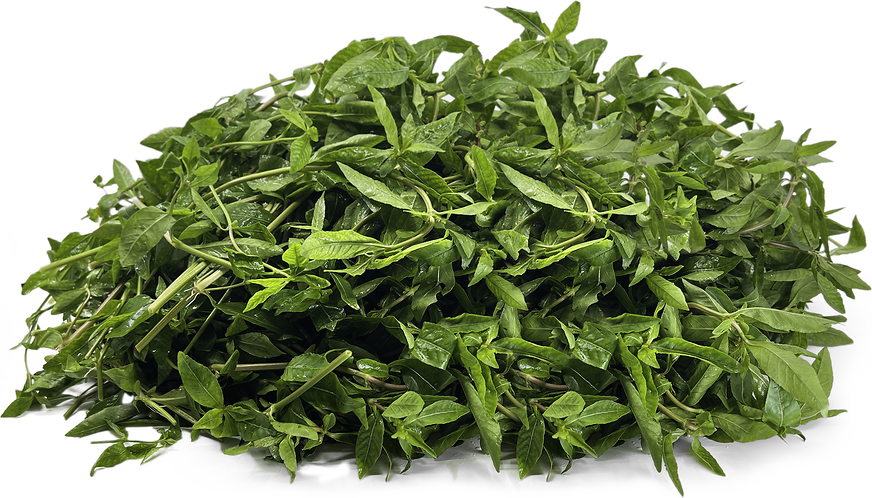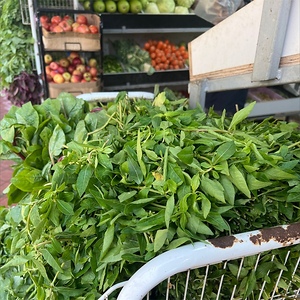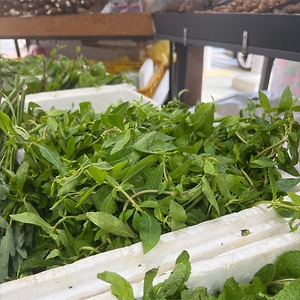


Ponnanganni Leaves
Estimated Inventory, lb : 0
Description/Taste
Ponnanganni leaves range in size from small to medium, depending on the type and growing conditions, and average 0.3 to 3 centimeters in diameter and 1 to 14 centimeters in length. Each leaf has an elongated, slender, lanceolate, to elliptic shape, tapering to a distinct point on the non-stem end. The leaf’s surface is lightly textured, smooth, and covered in prominent veining, and a midrib extends through the center. Ponnanganni leaves are sometimes covered in thin hairs or found smooth, and the leaves are thin, pliable, fleshy, and crisp. The leaves also vary in color from dark green to shades of purple-pink and release a musky, earthy scent from growing in traditionally damp environments. Ponnanganni leaves are mostly cooked before consumption and have a mild, nutty, earthy, and subtly bitter taste.
Seasons/Availability
Ponnanganni leaves are available year-round in tropical climates.
Current Facts
Ponnanganni leaves, botanically classified as Alternanthera sessilis, are a wild and cultivated plant belonging to the Amaranthaceae family. The flowering, perennial herb creeps low to the ground, reaching up to one meter in height, and roots at nodes along its branches, developing an intricate network of leaves, branches, and seasonal flowers. The name Ponnanganni is a Hindi and Tamil term for the species, and it is also called Ponnanganni Keerai, with Keerai meaning “greens.” Ponnanganni leaves are known by many names worldwide, including Keremak in Malaysia, Daun Tolod in Indonesia, Sissoo in Brazil, Lian Zi Cao or Bai Hua Zi in China, and Sessile Joyweed, Dwarf Copperleaf, Brazilian Spinach, and Tangle Mat in English. Within India, the species is known as Matikaduri in Assam, Kanchari in Maharashtra, Ponnagantikura in Andhra Pradesh, Phakchet in Manipur, and Kozhuppa or Ponnamkannikeera in Kerala. There are two main types of Ponnanganni, one with green leaves and one with purple-pink leaves, and the plants are grown commercially and in home gardens as a medicinal, culinary, and ornamental species. Ponnanganni leaves are a fast-growing species and are typically foraged or purchased in small bunches through local markets for cooked savory dishes. The leaves are treated like vegetables and can be used in a wide array of preparations.
Nutritional Value
Ponnanganni leaves are a source of iron to develop the protein hemoglobin for oxygen transport through the bloodstream, calcium to build strong bones and teeth, fiber to regulate the digestive tract, vitamin C to boost the immune system, and other nutrients, including vitamin A and phosphorus. The species, in general, is utilized worldwide in various natural medicines. Ponnanganni leaves are dried, ground into a powder, mixed into an oil, and inhaled for their natural scent to reduce headaches in India, and the leaves are traditionally used in Ayurvedic medicine to cleanse and improve overall dietary health. In Africa, Ponnanganni leaves are used to treat nausea, asthma, and vertigo. A paste is also made to soothe the skin and remove spines, and a powder made from the plant’s branches is applied over snakebites. The species is often consumed in South America to improve eye health and is sold worldwide in fresh, dried, capsule, oil, and paste form. It is important to note that Ponnanganni leaves contain some oxalates, which are naturally occurring toxic compounds. Oxalates can cause itchiness and rashes on the skin and make the throat and digestive tract inflamed. They can also cause worse symptoms, depending on the amount of raw leaves ingested. Consuming large amounts of Ponnanganni leaves is never advised, and most consumers choose to cook the leaves before consumption. Cooking dissipates oxalates in the leaves, making them suitable for consumption, and it is said that boiling is the best method.
Applications
Ponnanganni leaves have a mild, earthy, and green taste suited for fresh and cooked preparations. It is recommended to cook the leaves before consumption to remove oxalates, but some communities worldwide may shred and add the leaves to salads. Once washed and prepped, Ponnanganni leaves can be stir-fried with grated coconut and served with rice or boiled and mixed with aromatics as a simple vegetable dish. Ponnanganni leaves are used in dals, salads, and chutneys in India. They are also fried in a dish called poriyal, cooked in lentil-based vegetable stews known as sambar and kootu, or simmered in kuzhambu, a broth-based curry flavored with tamarind. In Southern India, the leaves are mixed with other ingredients and steamed in banana leaves or combined with fermented soybeans and stirred into rice. Outside India, Ponnanganni leaves are sauteed, boiled, steamed, or stir-fried into various vegetable and meat dishes, soups, salads, and side dishes. In South America, the greens are cooked into quiches, pasta, and used as a spinach substitute. The leaves are also pressed into a juice and consumed as a health beverage, as seen in Africa. Ponnanganni leaves pair well with aromatics such as garlic, ginger, shallots, and chile peppers, sesame oil, turmeric, cilantro, cumin seeds, tomatoes, carrots, radishes, and meats such as pork, beef, poultry, and fish. Freshly harvested Ponnanganni leaves should be immediately consumed for the best quality and flavor. The leaves will also keep for a few days when placed in a plastic bag and stored in the refrigerator.
Ethnic/Cultural Info
Ponnanganni leaves are known as the “golden plant” in Siddha medicine. The word “pon” translates from Indian dialects to mean “gold,” and medicinal practitioners divide the name up as “Pon-aagum-kaan-nee,” meaning “your body will acquire a golden luster.” The species became as precious as gold in Siddha due to its high nutritional properties. Siddha is an ancient medicinal system in India, especially in Southern India. Siddha means “established truth” and was thought to have been developed during the Indus civilization, sometime between 2,500 and 1,700 BCE. The medicinal system blends ancient remedies, practices, and mysticism. Siddhars, practitioners of Siddha medicine, are said to recommend consumers to eat Ponnanganni leaves for 48 days to heal and nourish the body. The increase in vitamins and minerals is said to make the “body glow” from the inside out, and the leaves are thought to keep the eyes healthy.
Geography/History
Ponnanganni leaves, or Alternanthera sessilis, are native to Asia and the Pacific Islands and have been growing wild since ancient times. Much of the species’ center of origin is debated among experts, with some pointing to China, while others say the plants came from a native range spanning from India to Southeast Asia. Regardless of their initial origins, Ponnanganni leaves are a fast-growing, hardy plant that easily naturalizes in other regions. The plant’s aggressive nature has allowed it to spread worldwide through natural causes, trade, and human migration, and in some parts of the world, the low-growing plants are considered an invasive species. The United States, South Africa, Namibia, and India all list the species as invasive. Today, Alternanthera sessilis thrives in damp forests, ditches, roadsides, ponds, swamps, canals, marches, rice fields, and other disturbed areas. The species is found in tropical to subtropical regions worldwide in North, Central, and South America, Europe, Africa, Asia, and Australia, and is even planted in the lower elevations of the Himalayas, around 200 to 2000 meters in height. Ponnangani leaves are sold in fresh markets worldwide and are also dried and sold as a medicinal ingredient through online retailers and market vendors.
Recipe Ideas
Recipes that include Ponnanganni Leaves. One
| GK Food Diary |
|
Ponnanganni Keerai Kootu |
| Saffron Trail |
|
Beet, Feta and Water Amaranth Salad |









